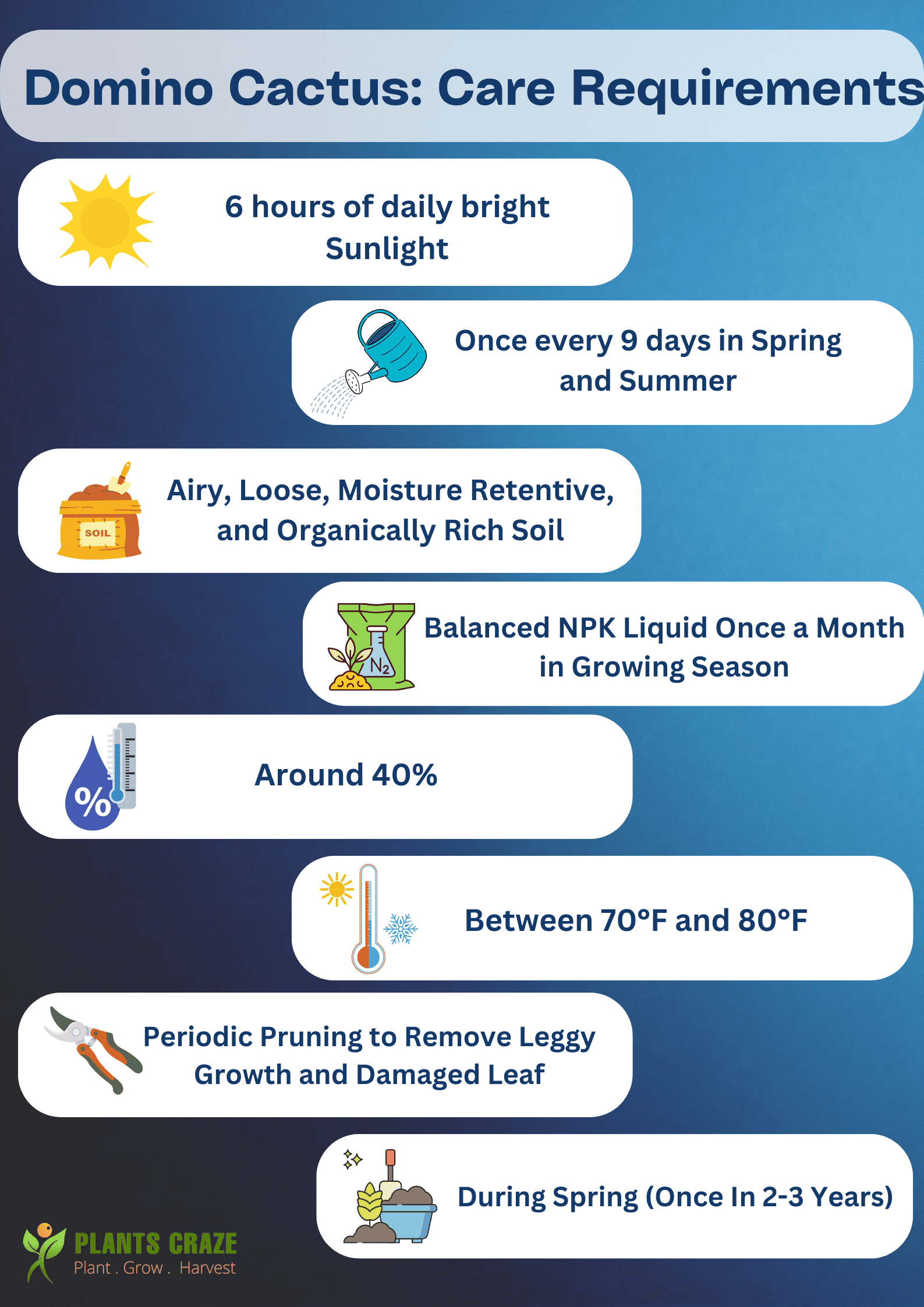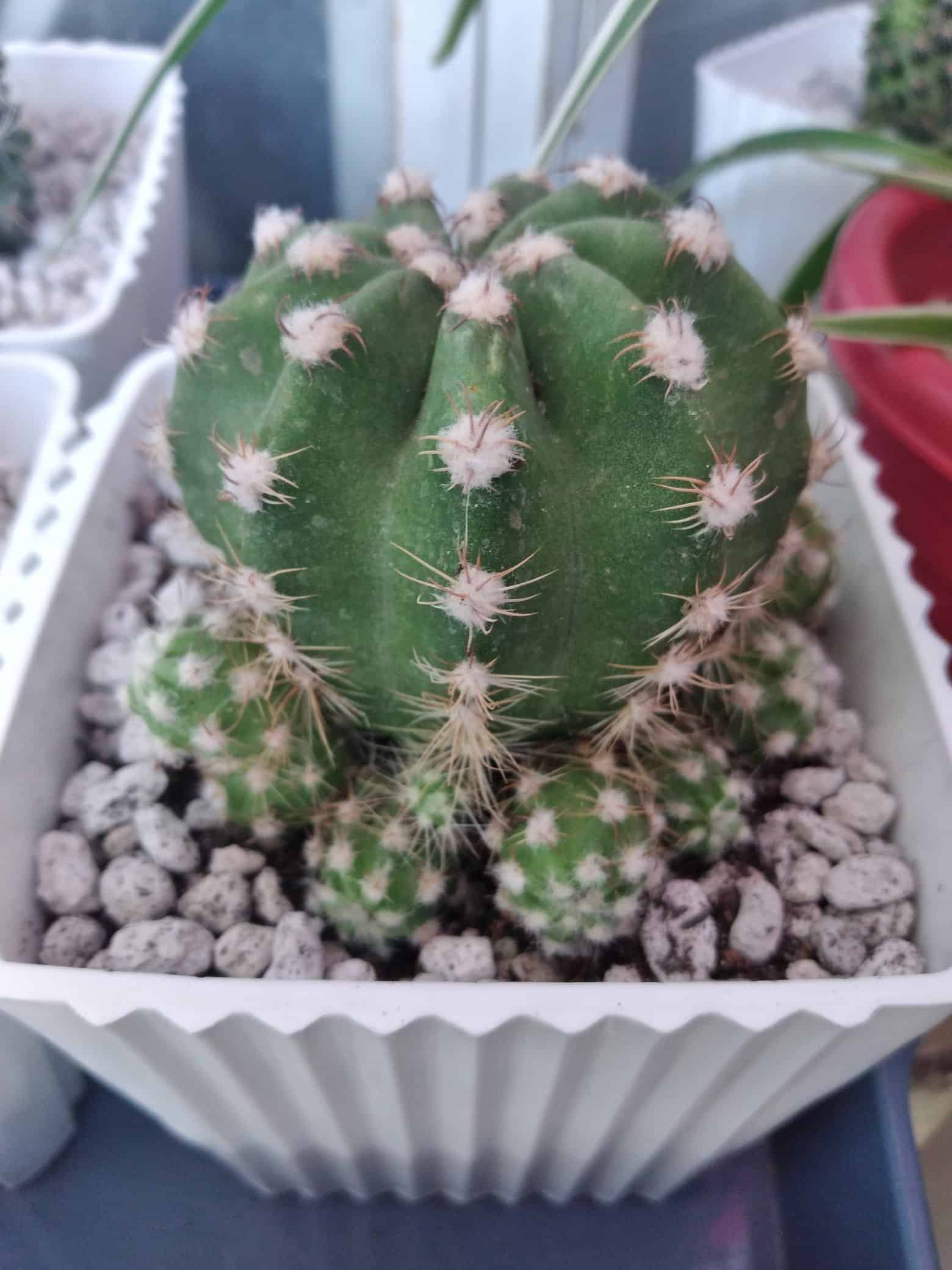The Domino Cactus holds soft radical spines in its emerald-green globular foliage, which can give out short-lived nocturnal blooms with minimal care.
Though Domino Cactus does not outsmart foliage plants, it serves succulent purposes well, so keep this article as the care guide!
Table of Contents Show
Overview of Domino Cactus
Famously known as Easter Lily Cactus, Domino Cactus is a native of Bolivia belonging to the Cactaceae family.
| Indicator | Identify |
|---|---|
| Scientific name | Echinopsis subdenudata |
| Common name | Domino Cactus, Night Blooming Hedgehog, Easter Lily Cactus |
| USDA Zone | 9 to 11 |
| Growth Rate | Slow to moderate |
| Plant Type | Perennial |
| Growth Size | 3 inches tall 4 inches wide |
| Foliage | Globular emerald stems with wooly spikes |
| Blooming | White florets over a long tubular stems |
| Grown for | Dome shaped foliage |
| Toxicity | Non-toxic |
Domino Cactus: A Detailed Care Guide
The Easter Lily Cactus demands a growth habitat similar to the mountain range and hills instead of a hot desert.

If you want to grow Domino Cactus problem-free, scroll down to get a complete dose of the care guide.
1. Sunlight & Temperature
Belonging to the Cacti family, Domino Cactus prefers full sun and hot days to boost its growth.
However, these Cactus plants are intolerant to cold drafts below 50ºF, as they will lose their vibrancy and start having soft tissue.
So you can keep them outdoors only during hot summer days and bring them indoors before cold drafts hit the plant.
Be sure to prevent scorching lights from falling on the Cactus if there are water drops, as the rays of light initiate plant burning in the presence of water.
If you plan to grow the plants indoors in the winter or without enough light, you can install grow lights and put heating mats under the pot to maintain the warmth.

The best location to keep Domino Cactus indoors is a window facing the South and a patio with enough light outdoors.
2. Watering & Humidity
Domino Cactus is drought tolerant but check the humidity around the plant before watering.
And remember to let the soil dry before the next watering to prevent overwatering that may lead to root rot, giving a mushy look and rotten smell from the plant side.
But do not wait too long until the Cacti suffer from underwatering, leading to wrinkling and shriveling up of the top.
So it is best to give 0.9 cups of water every nine days during summer and mist the plant every 12 days in the dormant period.
Meanwhile, you can install a dehumidifier beside the Cacti to maintain the dry air.
And move the plants from moist places, including the kitchen or bathroom, to a drier zone to prevent disease infestation, mold, and fungus formation.
3. Soil & Fertilization
Domino Cactus flourishes more in well-draining soil with low water retention quality and rich manure content with a pH of 5-7.
You can buy the soil from the online store for Cactus or succulent mix or make your DIY potting soil.
Moreover, you can apply Cacti or balanced fertilizer directly into the roots monthly during spring and summer.
But it is better to offer the natural organic mix as it is not a heavy feeder, mainly in winter, as they are dormant.
Excess fertilization suffocates your Cactus and causes the wooly green foliage to turn yellow and have brown spots.
Also, keep the soil dry rather than soggy to prevent pest infestation.
4. Potting and Repotting
Domino Cactus is not fussy regarding the container as long as it matches the plant size and has enough drainage holes.
The bigger pot leads to overwatering and soggy soil, consuming time to dry out and ultimately inviting rot.
So choose a terracotta pot 5 inches wide and 6 inches deep. And after 2-3 years, repotting becomes an option, given the slow growth of Cactus.
However, you might need to repot them once they have pups or are suffering from soil problems.
So repot them indoors during summer into an inch bigger pot, but check for dryness in the soil before repotting to prevent shock to the Cacti.
Lastly, cover the top with the mix, let it stay dry for at least a week, and offer light water.
5. Occasional Pruning
Given the unique globular foliar structure, Domino Cactus demands less or no pruning.
The most common pest attacking Domino Cactus are scales or thrips that tend to hide beneath the wooly areoles.
So, look over symptoms like plants appearing weak, thin, and white substance over the foliage for the presence of pests.
You can control the infestation by trimming the damaged parts off and spraying rubbing alcohol, insecticidal soap or neem oil over the affected area.
Moreover, the Cacti can also be a victim of fungal diseases like root rot and black spots over the foliage, where pruning comes into action the most.
But firstly, you have to isolate the Cacti from other plants and cut off the affected part using sterilized garden pruners or scissors.
Domino Cactus: All About Growth Rate
All members of the Cactus family are famous for their slow growth, same for Domino Cactus.
This Cacti can reach up to 3 inches in height and 4 inches wide indoors in about 1-2 years, while about 12 inches outdoors when provided ideal growing conditions.

Meanwhile, the Domino dots gives out 3 to 4 white funnel-shaped blooms simultaneously during the summer on the top of a stem extending up to 9 inches.
Moreover, the Domino Cactus spherical foliage has an areole bearing one central and 3-7 radial spines that are soft and not prickly and rises to pups and offsets once they grow old.
Toxicity of Domino Cactus
Feel secure about bringing Domino Cactus home as they are not toxic to humans or pets like cats and dogs.
However, it is better to keep them away from the reach of children and companion pets as they might chew up on them and create discomfort in the stomach.
Also, the sharp thorns can pierce the skin, leaving wounds and pain.
Contact the emergency helpline if anything goes wrong with your pet or you.
Propagation Methods for Domino Cactus
You can use seeds and offsets from the plant body to propagate Domino Cactus in spring and summer.
Follow the steps below to understand the entire step of propagating.
1. Propagation via seeds
Although the seeds of Domino Cactus are difficult to come across, you can still find them in online stores.
- Start sowing the seed in early spring till late spring.
- Fill a terracotta pot with the Cactus mix and pebbles as a liner in the pot for proper drainage and aeration.
- Spread the seed over the top and cover the seed with twice the depth of the seed if they are large and for smaller ones, cover lightly with sand.
- Lastly, mist the seed to make the soil moist and put it in an area with enough sunlight and a temperature around 70ºF.
- Alternatively, you can cover the pot with a plastic bag or glass to maintain the temperature and humidity and open it regularly to allow airflow.
2. Propagation via Offsets
Offsets are small pups that you can find easily at the base of the mother Domino Cactus, near the roots.
- Start the process in early spring to anytime until late summer.
- Cut off the offsets gently using a sterile knife, or you can even twist it off using your finger without hurting the mother plant.
- Then, place the offsets over a paper towel to let it dry and allow a callous to form over the cut.
- Once the cut has healed, plant the pup into a pot filled with a cactus mix. You can even use a toothpick to provide support to the new offsets.
- Keep the pot in a warm area and water it lightly until new roots emerge.
Domino Cactus for Sale
You can look out for the sites below to bring a new Domino Cactus to your houseplant collection.
| Sites | Shipping Time |
|---|---|
| Amazon | Within 2 to 3 days |
| Etsy | Within 3 to 4 days |
| Succulent box | Within 3 to 5 days |
| Plantly | Within 10 days |
Closing Thought
Echinopsis Subdenudata ‘Domino’ is a forgiving plant, bringing value to your interior gardening with less demand in daily care.
Therefore, even novice or part-time plant owners and enthusiasts can add the Domino to their bookshelves, bedroom or garden.


